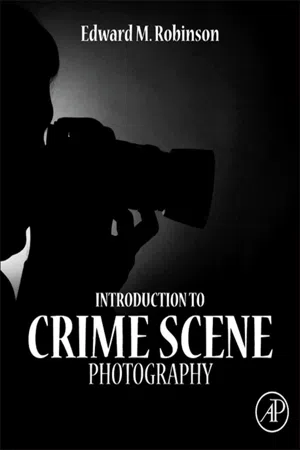![]()
Chapter 1
An Overview of Crime Scene Photography and Composition
Contents
Photo Documentation Forms
Composition and Full Field of View Responsibility
Chapter Summary
Learning Objectives
Upon completion of this lesson, you will be able to:
Explain the three cardinal rules of good photography
Explain how the same subject can be composed differently in various images
Explain why “fill the frame” has two aspects: both a positive and a negative connotation
Explain why good composition partly depends on the point of view of the photographer
Explain why the careful written documentation of each photograph is necessary
Explain three techniques by which photographs are documented
Explain how overall photographs relate to the general crime scene area
Explain how exterior overall photographs are to be taken
Explain how interior overall photographs are to be taken
Explain how midrange photographs are best taken
Explain the four types of close-up photographs
Explain additional types of photographic concerns related to documenting the wounds of suspects and victims
Explain the complete photographic documentation of a homicide victim
Key Terms
Cardinal Rule I: Fill the Frame
Cardinal Rule II: Keep the Film Plane Parallel
Cardinal Rule III: Maximize the Depth of Field (DOF)
Close-up photographs
Composition
Depth of field (DOF)
Examination-quality photographs
Exterior overalls
Full-body panorama
Full field of view responsibility
Hard shadows
Interior overalls
Isosceles triangle
Labeled scale
Lens distortion
Lens flare
Midrange photographs
Natural perspective
Overall photographs
Perspective distortion
Photo identifier
Photographic
Photo memo form
Scales on the same plane
Shadow control
Soft shadows
SWGs
SWGIT
SWGFAST
SWGTREAD
Wagon wheel ellipse
Crime scene photography is very different from many other types of photography. Creative and artistic photography often follow very different rules, which is perfectly fine. But crime scene photography differs from other variations of photography because the crime scene photographers usually have a very specific purpose for capturing each image. There is a specific job to be done and specific types of images that have to be captured. Nevertheless, the crime scene photographer, at times, has to be very creative to successfully get the shot. But instead of the creativity being the purpose of the shot, the creativity necessary to capture a crime scene image should almost be unnoticed.
Crime scene photography serves several purposes. For those who were at the original crime scene, these images will help refresh their memory after a period of time has gone by. For those who could not be present at the original crime scene, it provides them with the opportunity to see the crime scene and the evidence within the crime scene. This purpose can apply to other law enforcement professionals who will become involved with the case and will later apply when the case goes to trial. The judge, jury, attorneys, and witnesses can all benefit from seeing the original crime scene images. And sometimes the images captured at the crime scene may be one way to actually walk away from the crime scene with the evidence. Often, photography is the only way to actually collect the evidence. Therefore, crime scene photography is a method to:
Document the crime scene and the evidence within the crime scene,
Collect the evidence. These images can then be later used as examination-quality photographs by experts/analysts from the forensic laboratory.
This book will help the reader not only to understand what images should be taken but will also explain how a digital SLR (single-lens reflex) camera system should be used to optimally capture these required images.
The authors have extensive experience with crime scene photography. We will, of course, use our experience to convey to the reader both the photographic principals and techniques we have successfully used in the field. Perhaps even more important, this text will base much of its information on the recommendations of the various Scientific Working Groups (SWGs) as they apply to crime scene photography. In particular, we will rely on the Scientific Working Group on Imaging Technology (SWGIT1), the Scientific Working Group on Shoeprints and Tire Tracks (SWGTREAD2), and the Scientific Working Group on Friction Ridge Analysis, Standards, and Technology (SWGFAST3)—latent print examiners. These SWGs maintain their recommendation on their websites, which can be updated and revised as necessary.
The authors will rely on the SWG documents that were current as this text was written. Therefore, you need not rely on the experience of just the three authors; you will be able to also rely on all the professionals involved with the SWGs, whose members include working crime scene photographers, researchers, and academics.
Photo Documentation Forms
Because crime scene images can be offered in court as evidence, they are subject to normal chain-of-custody rules and eventually must be offered to the court as evidence by an individual who will have to swear that they are a “fair and accurate representation of the scene.” In order to establish that individual images meet these standards, three types of documentation have traditionally been used.
The Photo Identifier
At the beginning of every series of photographs of a crime scene, the very first image captured is usually of the photo identifier after it has...















